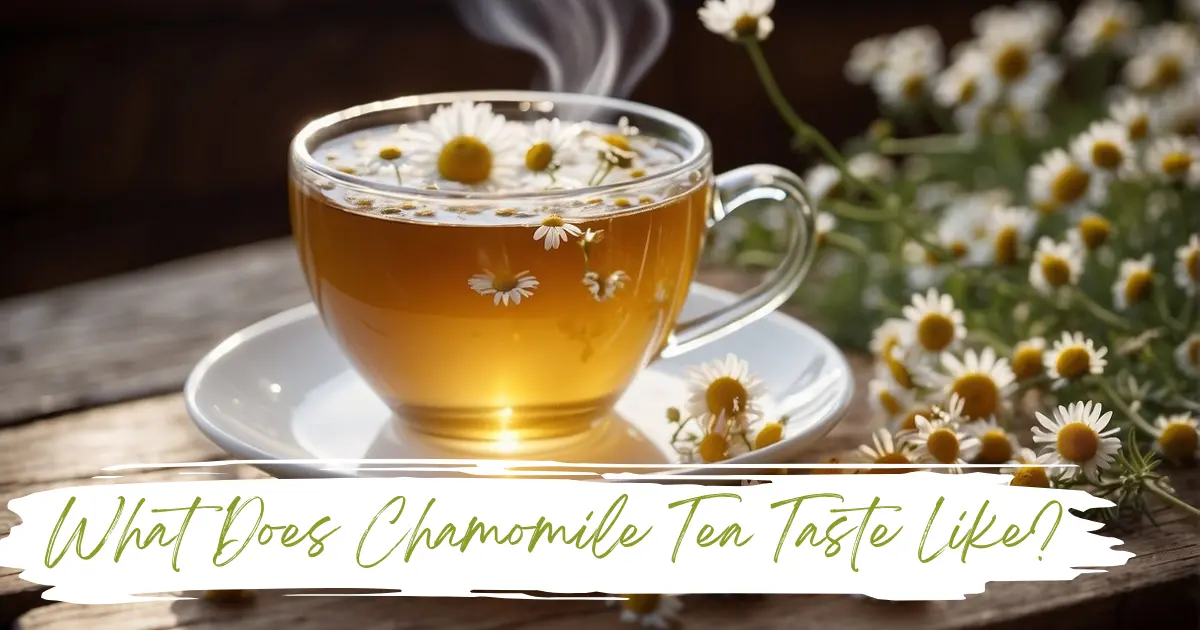Chamomile tea is a popular herbal infusion celebrated for its calming properties and unique flavor profile. But questions about its taste, smell, sweetness, and compatibility with other flavors often arise. In this comprehensive guide, we’ll dive deep into the nuances of chamomile tea to help you better understand and enjoy this herbal delight.
What Does Chamomile Tea Taste Like?
Chamomile tea is often described as having a mild, floral, and slightly sweet taste, with subtle earthy undertones. Its flavor is reminiscent of apples, a quality derived from the compound apigenin found in chamomile flowers.
Table: Chamomile Tea Taste Characteristics
| Flavor Profile | Description |
|---|---|
| Floral | Light and soothing floral notes |
| Sweet | Subtle natural sweetness |
| Earthy | Mild earthy undertones |
| Apple-like | Reminiscent of crisp apples |
Why Does Chamomile Tea Taste Terrible to Some?
For some individuals, chamomile tea may taste “terrible” due to personal taste preferences or brewing techniques. Oversteeping the tea can result in a bitter or overly strong flavor. Additionally, using poor-quality chamomile or stale tea bags can negatively impact its taste.
Tips to Enhance the Taste of Chamomile Tea:
- Choose Fresh Chamomile: Use high-quality, fresh loose-leaf chamomile for optimal flavor.
- Proper Steeping Time: Steep for 4-5 minutes at 90°C (194°F).
- Sweeteners: Add honey or a pinch of sugar for enhanced sweetness.
- Pairings: Enjoy with foods that complement its flavors, such as apples or honey-based desserts.
Why Does Chamomile Tea Smell So Bad to Some People?
Chamomile tea has a distinct aroma that some may find unpleasant. This scent is influenced by its high levels of volatile compounds such as bisabolol and matricin, which contribute to its therapeutic properties but can also create a pungent aroma.
What Does Chamomile Tea Smell Like?
Chamomile tea typically smells floral, earthy, and mildly sweet, with a slight apple-like fragrance. For some, these characteristics may be interpreted as “bad” or overwhelming.
Table: Chamomile Tea Smell Components
| Aroma Component | Characteristic Smell |
|---|---|
| Bisabolol | Sweet, floral |
| Matricin | Earthy, herbal |
| Apigenin | Mild apple-like |
How to Enjoy Chamomile’s Unique Aroma?
- Experiment with Blends: Combine chamomile with other herbal teas like mint or lavender to balance its aroma.
- Aromatic Enhancements: Add a slice of fresh lemon or a cinnamon stick for a fresher scent.
Does Chamomile Tea Have Caffeine?
No, chamomile tea is naturally caffeine-free. This makes it an excellent choice for relaxation, particularly in the evening when you want to unwind without the stimulating effects of caffeine.
Is Chamomile Tea Naturally Sweet?
Chamomile tea has a subtle natural sweetness that doesn’t overpower its flavor. This quality makes it a favorite for those who prefer herbal teas without added sugar.
How to Enhance the Sweetness?
For a sweeter taste, pair chamomile tea with:
- Honey: A natural and healthy sweetener.
- Fruit: Add slices of apple or pear.
- Vanilla Extract: A dash can enhance its sweetness naturally.
Does Chamomile Taste Like Apple?
Yes, chamomile tea is often noted for its apple-like flavor. The name “chamomile” is derived from the Greek words chamaimēlon, meaning “earth apple,” which reflects this characteristic.
Chamomile Tea Pairings:
Pairing chamomile tea with complementary flavors can elevate your tea-drinking experience.
Table: Chamomile Tea Pairing Suggestions
| Pairing Type | Examples |
|---|---|
| Fruits | Apple slices, pears, citrus |
| Sweeteners | Honey, maple syrup |
| Desserts | Shortbread, honey cake |
| Herbal Blends | Mint, lavender, lemon balm |
Perfect Times to Enjoy Chamomile Tea
- Before Bed: Paired with a light dessert for relaxation.
- Mid-Afternoon: With a fruit salad for a refreshing break.
Conclusion
Chamomile tea is a delightful herbal infusion with a distinct taste, aroma, and numerous health benefits. From its natural sweetness and apple-like flavor to its calming effects and caffeine-free nature, chamomile tea offers something for everyone. Whether you enjoy it plain or paired with complementary flavors, understanding its unique characteristics can enhance your tea-drinking experience.
Embrace the versatility of chamomile tea by experimenting with pairings, blending it with other teas, or enjoying its natural essence. The next time you brew a cup, savor the mild floral notes, sweet undertones, and apple-like aroma that make chamomile tea a timeless favorite.
FAQs
Why does chamomile tea taste bitter sometimes?
Oversteeping chamomile tea can extract excessive tannins, leading to a bitter taste. Stick to a steeping time of 4-5 minutes for the best flavor.
What can I add to chamomile tea to improve its taste?
Enhance the flavor with honey, lemon, cinnamon, or mint leaves for a refreshing twist.
Does chamomile tea lose its taste over time?
Yes, chamomile tea can lose its flavor if not stored properly. Keep it in an airtight container away from light and moisture.
Can chamomile tea help with sleep?
Yes, chamomile tea is known for its calming effects and can promote better sleep due to its natural compounds like apigenin.
Is chamomile tea safe for everyone?
While generally safe, individuals allergic to ragweed or daisies should avoid chamomile tea. Consult a doctor if unsure.

